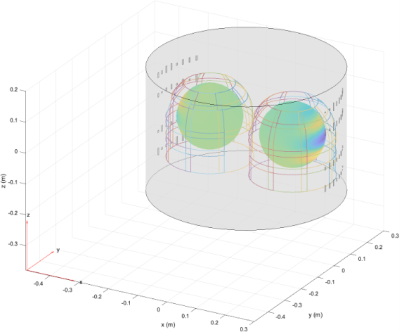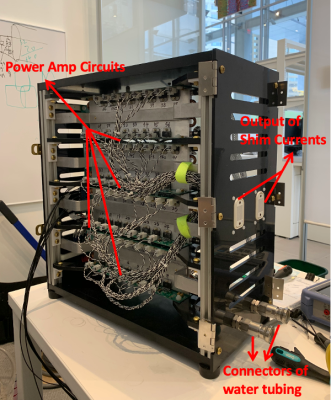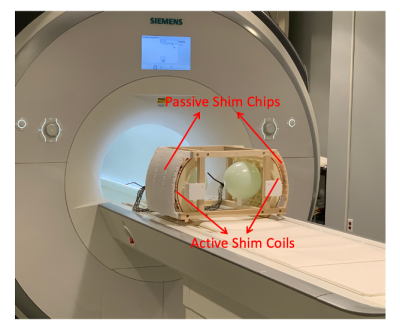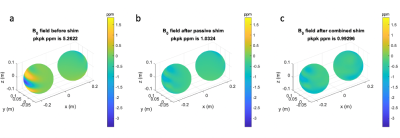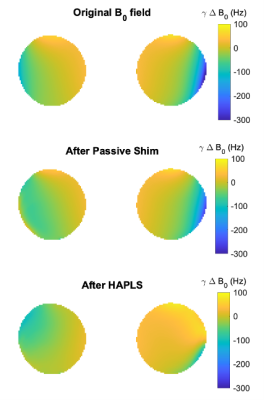3327
Hybrid Active and Passive Local Shimming (HAPLS) for Two-region Magnetic Resonance Imaging (MRI)1Zuckerman Institute, Columbia University, New York, NY, United States, 2Harvard Medical School, Boston, MA, United States, 3Athinoula A. Martinos Center for Biomedical Imaging, Massachusetts General Hospital, Boston, MA, United States, 4Siemens Healthcare GmbH, Erlangen, Germany
Synopsis
When the bilateral regions of intersest are far off isocenter like in case of shoulders or for brains of two people to be scanned simultaneously, the image quality often suffers from non-optimal spherical harmonic based shimming routine and higher field inhomogeneity in large off-isocenter regions. To address these challenges, a hybrid active and passive local shimming (HAPLS) technique is proposed to shim two isolated areas in one field of view (FOV) simultaneously. Both the simulation and experimental results validated that HAPLS can complementarily address the bifocal and high-order inhomogeneities in the two-region MRI.
Introduction
The typical region of interest (ROI) for MR scanning is one region close to the isocenter of the magnet. This region has usually a spherical or ellipsoid shape. All subsystems, magnet, B0 shim, body coil for B1 excitation, are optimized to this ROI. However, the human body has a left-right bilateral design in several body areas, e.g. knees, breasts. When the bilateral regions are far off the isocenter like in the case of shoulders or for brains of two people to be scanned simultaneously1, the image quality often suffers because of (1) the spherical harmonic based shimming routine becomes non-optimal and (2) the larger off-isocenter location of the two imaging volumes results in a higher field inhomogeneity. To address these challenges, a hybrid active and passive local shimming (HAPLS) technique is proposed to shim two isolated areas in one field of view (FOV) simultaneously.Methods
In the proposed method, the passive shimming is more focused to compensate the high-order B0 field inhomogeneity2, while the active shimming deals more with the low-order B0 field inhomogeneity, and the subject-specific susceptibility fields3-4. The illustration of the proposed HAPLS approach is shown in Fig. 1. The passive shimming is implemented by affixing the ferromagnetic chips (VACOFLUX 50, Vacuumschmelze Gmbh, Germany) surrounding the subjects with optimized dimensions and locations. A current model is applied to the forward calculation of the field generated by ferromagnetic chips5, and a constrained nonlinear optimization was performed in MATLAB (Mathworks, MA, USA). To implement the active shimming, a low-cost shim current supply system was constructed based on the previously reported system6, and the photo of the shim system is shown in Fig. 2. It supports up to 64 channels of active shimming, and up to 2.5 A per channel with a water cooling system to help the heat dissipation. Also, a 40-channel bilateral local active shimming coil array was constructed. Each side has 4x5 elements, and each element has a dimension of 76x70 mm2 and 10 turns of the AWG 20 copper wire. Both active and passive shimming components are mounted to a wooden frame, and two 165-mm Siemens phantoms were used to test its performance as shown in Fig. 3. The optimization results of the HAPLS approach are shown in Fig. 4. As shown, with HAPLS approach, the pk-pk ppm was reduced from 5.26 ppm to 0.99 ppm by about 81%, and the frequency range containing 95% MR pixels decreased from 2.08 ppm to 0.57 ppm by about 72%.Experiment Results
To acquire the field map of each shim coil, the double-echo gradient-echo field mapping sequence was performed on the 3T Siemens Magnetom Prisma scanner (Siemens AG, Healthcare Sector, Erlangen, Germany) with $$$\pm$$$0.25 A for each channel. During imaging, the built-in shimming in prescan was by-passed, so that the background B0 is based on the default system tune-up shimming. A subtraction was made between two maps of $$$\pm$$$0.25 A for each shim coil to remove the background inhomogeneous B0 field, then a constrained nonlinear optimization was performed based on acquired field maps to get the optimal current distribution for all channels in MATLAB. The gradient echo-based field maps after applying passive shim alone and HAPLS approach were collected and shown in Fig. 5. With passive shim alone, the 95% frequency bandwidth within the central xy-plane in two phantoms was reduced from 218 Hz to 188 Hz by about 13.8%. With HAPLS approach, the 95% frequency bandwidth decreased from 218 Hz to 148 Hz by about 32.3%.Conclusion & Discussion
The hybrid active and passive local shimming can complementarily address the bifocal and high-order inhomogeneities in the two-region MRI. Both the simulation and preliminary experimental results validated the feasibility of the proposed method, although the geometrical precision of the passive shimming need to be further improved. More systematic experimental design and optimization will prepare the proposed approach for the in vivo two-region MR scan in the near future.Acknowledgements
This project is supported by NSF 1926789.References
[1] Lee, Ray F., W. Dai, and J. Jones. "Decoupled circular‐polarized dual‐head volume coil pair for studying two interacting human brains with dyadic fMRI." Magnetic Resonance in Medicine 68.4 (2012): 1087-1096.
[2] Yang, Sejung, et al. "Local in vivo shimming using adaptive passive shim positioning." Magnetic resonance imaging 29.3 (2011): 401-407.
[3] Juchem, Christoph, et al. "Multi‐slice MRI with the dynamic multi‐coil technique." NMR in Biomedicine 28.11 (2015): 1526-1534.
[4] Stockmann, Jason P., and Lawrence L. Wald. "In vivo B0 field shimming methods for MRI at 7 T." NeuroImage 168 (2018): 71-87.
[5] Ren, Zhi Hua, Wen Chuan Mu, and Shao Ying Huang. "Design and optimization of a ring-pair permanent magnet array for head imaging in a low-field portable MRI system." IEEE Transactions on Magnetics 55.1 (2018): 1-8.
[6] Stockmann, Jason P., et al. "A 32‐channel combined RF and B0 shim array for 3T brain imaging." Magnetic resonance in medicine 75.1 (2016): 441-451.
Figures
